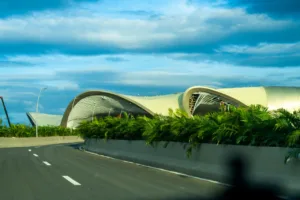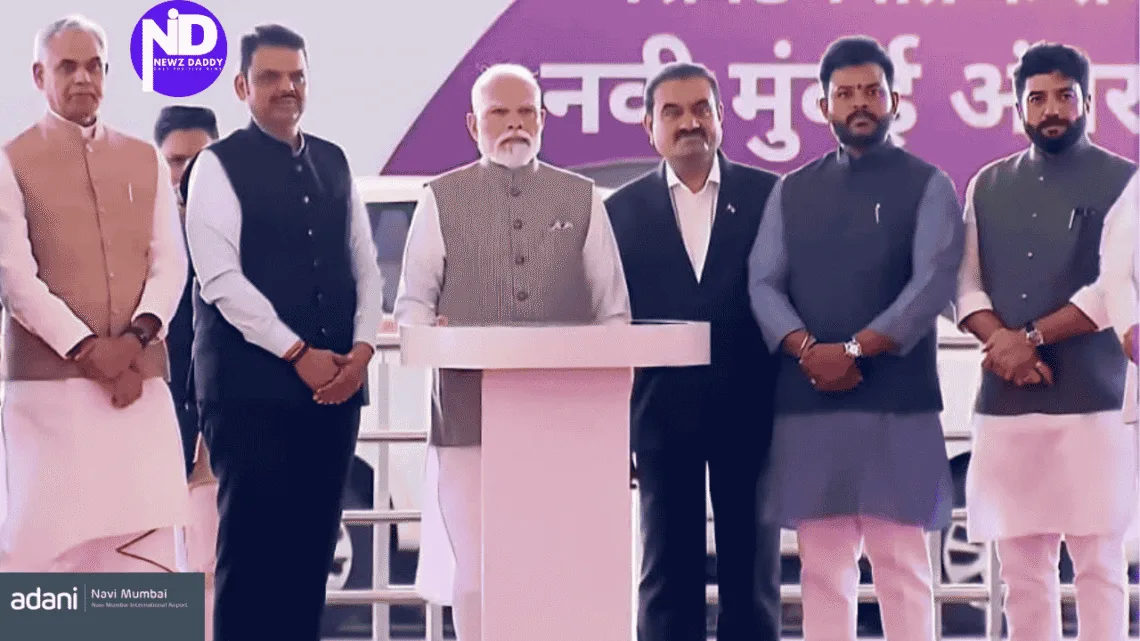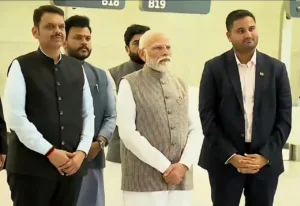PM Modi Launches Navi Mumbai International Airport
Newzdaddy Business Updates
Prime Minister of India Shri Narendra Modi today inaugurated the Navi Mumbai International Airport (NMIA), one of India’s most ambitious infrastructure projects and a defining milestone in the nation’s aviation journey. Speaking on the occasion, the Prime Minister said that Mumbai’s long wait was over as the city had now received its second international airport. He added that the Navi Mumbai International Airport would play a major role in establishing the region as Asia’s biggest connectivity hub.
This new airport is expected to handle millions of passengers every year, taking pressure off the busy Chhatrapati Shivaji Maharaj International Airport. Experts believe it will change how people and goods move in western India. It is also expected to boost the economy, create thousands of jobs, and improve logistics for both passengers and industries in Maharashtra and nearby states.
“The Navi Mumbai International Airport is a project that exemplifies the vision of a developed India,” said the Prime Minister after inaugurating the airport. “It is built on the land of Chhatrapati Shivaji Maharaj, and its design, resembling a lotus flower, makes it a living symbol of culture and prosperity. This new airport will connect Maharashtra’s farmers directly with the international supply chain, including supermarkets in Europe and the Middle East. This means that the farmers’ freshest produce, fruits, flowers, vegetables and the products of our fisherfolk, will be able to reach the global market rapidly. For the small and micro-scale industries in the area, this infrastructure will reduce logistical costs. It is set to attract increased investment, fostering the creation of new industries and ventures. I extend my heartiest congratulations to all the people of Maharashtra and Mumbai on the establishment of this airport.”
This statement highlights the airport’s role in rural development. With modern cargo facilities, perishable goods
such as seafood, fruits, and vegetables will get to markets more quickly. Mangoes, grapes, flowers, and marine products are among the top products produced in Maharashtra, India. Farmers will benefit from lower waste and higher pricing thanks to direct air cargo routes to Europe and the Middle East.
Along with Maharashtra Governor Shri Acharya Devvrat, Maharashtra Chief Minister Shri Devendra Fadnavis, Union Minister for Civil Aviation Shri Ram Mohan Naidu Kinjarapu, Maharashtra Deputy Chief Ministers Shri Ajit Pawar and Shri Eknath Shinde, Union Minister of State for Civil Aviation Shri Murlidhar Mohol, and Adani Airports Director Shri Jeet Adani, the Prime Minister visited the airport and examined its top-notch amenities before his speech. The Prime Minister viewed the airport master plan and was also shown the various tech aspects of the terminal.
The Navi Mumbai International Airport has advanced security systems, automated check-ins, and smart baggage handling. Its design focuses on reducing passenger travel time inside the terminal. Special attention has been given to sustainability, including solar power, water recycling, and green building standards.
NMIA is a historic public-private partnership (PPP) that was created by the City and Industrial Development Corporation (CIDCO) and Mumbai International Airport Limited (MIAL), a division of Adani Airport Holdings Limited (AAHL). The project reflects the government’s Viksit Bharat 2047 plan and marks a significant advancement in India’s infrastructure-building vision.
In Indian aviation, this PPP model is regarded as one of the biggest. Adani Group has already acquired control of a number of Indian airports, bringing efficiency and private investment. In terms of planning and land development, CIDCO was crucial.
We have constructed more than just an airport in a time when India is becoming one of the biggest economies in the world; we have designed Bharat as a gateway and as one of the most important intersections in the world,” stated Shri Gautam Adani, Chairman of the Adani Group. This infrastructure generates exponential possibilities for the future in addition to meeting today’s demands. Every flight through these terminals will transport not only passengers for generations to come, but also the hopes, aspirations, and accomplishments of a country recovering its position at the forefront of world advancement, as well as the pulse of a defining superpower.
It is anticipated that the airport will develop into a major hub for both domestic and foreign airlines. India’s passenger traffic is increasing quickly, according to aviation experts, and having several airports in the country’s largest cities will facilitate and lower the cost of air travel.
 NMIA is envisioned as a supplementary airport to Chhatrapati Shivaji Maharaj International Airport (CSMIA) as part of a dual-airport system for the Mumbai Metropolitan Region (MMR). The airport will eventually grow to handle 90 million passengers annually (MPPA), making it one of India’s biggest airports for passenger handling. Its initial capacity was 20 MPPA.
NMIA is envisioned as a supplementary airport to Chhatrapati Shivaji Maharaj International Airport (CSMIA) as part of a dual-airport system for the Mumbai Metropolitan Region (MMR). The airport will eventually grow to handle 90 million passengers annually (MPPA), making it one of India’s biggest airports for passenger handling. Its initial capacity was 20 MPPA.
This scale puts Navi Mumbai International Airport in line with some of Asia’s biggest airports, like Singapore’s Changi and Dubai International.
According to Shri Jeet Adani, Director of Adani Airport Holdings Ltd., “NMIA is a landmark in India’s aviation journey, uniting cutting-edge technology, sustainability, and a passenger-first experience.” “It strengthens Mumbai’s position as a major international aviation hub and establishes a model for future-ready airports across the country by enhancing CSMIA.”
Designed as a multimodal hub, NMIA will be easily connected to suburban rail networks, planned waterways, Navi Mumbai, Mumbai Metro, and the Mumbai Trans Harbour Link. Through this integration, travel times will be shortened, regional connections will be improved, and the flow of passengers and commodities across western India’s extensive hinterland will be strengthened.
One of the longest sea crossings in India, the Mumbai Trans Harbour Link, would be crucial in linking the airport with the city centre. People from South Mumbai and other areas will be able to get to the airport more quickly thanks to this.
NMIA’s architecture, which draws inspiration from the lotus, India’s national flower, combines world-class design and sustainability elements with cultural legacy to create an airport that is both deeply ingrained in Indian culture and in line with future goals.
NMIA will have a single runway and terminal that can accommodate 20 MPPA during its first two phases of operation. The airport will eventually grow to four runways and several terminals, with a specialised cargo terminal and cutting-edge capabilities for express and perishable goods, strengthening India’s trade and logistics network.
The opening of NMIA demonstrates India’s commitment to building top-notch, future-ready infrastructure that fosters economic expansion, international competitiveness, and the ambitions of its people. NMIA is a representation of contemporary engineering, teamwork, and India’s growing prominence in the world of aviation as the country moves closer to Viksit Bharat 2047.
Must Read:
Adani Airports Breaks Records as Navi Mumbai Nears Completion







